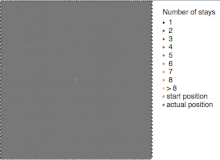Brownian motion, or pedesis (from Ancient Greek: πήδησις /pɛ̌ːdɛːsis/ "leaping"), is the random motion of particles suspended in a medium (a liquid or a gas).[2]
This pattern of motion typically consists of random fluctuations in a particle's position inside a fluid sub-domain, followed by a relocation to another sub-domain. Each relocation is followed by more fluctuations within the new closed volume. This pattern describes a fluid at thermal equilibrium, defined by a given temperature. Within such a fluid, there exists no preferential direction of flow (as in transport phenomena). More specifically, the fluid's overall linear and angular momenta remain null over time. The kinetic energies of the molecular Brownian motions, together with those of molecular rotations and vibrations, sum up to the caloric component of a fluid's internal energy (the Equipartition theorem).
This motion is named after the botanist Robert Brown, who first described the phenomenon in 1827, while looking through a microscope at pollen of the plant Clarkia pulchellaimmersed in water. In 1905, almost eighty years later, theoretical physicist Albert Einsteinpublished a paper where he modeled the motion of the pollen particles as being moved by individual water molecules, making one of his first major scientific contributions.[3] The direction of the force of atomic bombardment is constantly changing, and at different times the particle is hit more on one side than another, leading to the seemingly random nature of the motion. This explanation of Brownian motion served as convincing evidence that atomsand molecules exist and was further verified experimentally by Jean Perrin in 1908. Perrin was awarded the Nobel Prize in Physics in 1926 "for his work on the discontinuous structure of matter".[4]
The many-body interactions that yield the Brownian pattern cannot be solved by a model accounting for every involved molecule. In consequence, only probabilistic models applied to molecular populations can be employed to describe it. Two such models of the statistical mechanics, due to Einstein and Smoluchowski, are presented below. Another, pure probabilistic class of models is the class of the stochastic process models. There exist sequences of both simpler and more complicated stochastic processes which converge (in the limit) to Brownian motion (see random walk and Donsker's theorem).[5][6]
History
The Roman philosopher-poet Lucretius' scientific poem "On the Nature of Things" (c. 60 BC) has a remarkable description of the motion of dust particles in verses 113–140 from Book II. He uses this as a proof of the existence of atoms:
Although the mingling motion of dust particles is caused largely by air currents, the glittering, tumbling motion of small dust particles is caused chiefly by true Brownian dynamics; Lucretius "perfectly describes and explains the Brownian movement by a wrong example".[8]
While Jan Ingenhousz described the irregular motion of coal dust particles on the surface of alcohol in 1785, the discovery of this phenomenon is often credited to the botanist Robert Brown in 1827. Brown was studying pollen grains of the plant Clarkia pulchellasuspended in water under a microscope when he observed minute particles, ejected by the pollen grains, executing a jittery motion. By repeating the experiment with particles of inorganic matter he was able to rule out that the motion was life-related, although its origin was yet to be explained.
The first person to describe the mathematics behind Brownian motion was Thorvald N. Thiele in a paper on the method of least squares published in 1880. This was followed independently by Louis Bachelier in 1900 in his PhD thesis "The theory of speculation", in which he presented a stochastic analysis of the stock and option markets. The Brownian motion model of the stock market is often cited, but Benoit Mandelbrot rejected its applicability to stock price movements in part because these are discontinuous.[9]
Albert Einstein (in one of his 1905 papers) and Marian Smoluchowski (1906) brought the solution of the problem to the attention of physicists, and presented it as a way to indirectly confirm the existence of atoms and molecules. Their equations describing Brownian motion were subsequently verified by the experimental work of Jean Baptiste Perrin in 1908.
https://en.wikipedia.org/wiki/Brownian_motion
https://en.wikipedia.org/wiki/Avogadro_constant
https://en.wikipedia.org/wiki/Johann_Josef_Loschmidt
https://en.wikipedia.org/wiki/Jean_Baptiste_Perrin




No comments:
Post a Comment